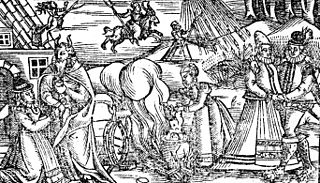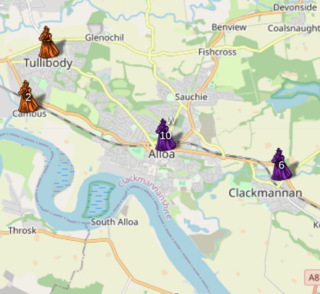
Isobel Gowdie was a Scottish woman who confessed to witchcraft at Auldearn near Nairn during 1662. Scant information is available about her age or life and, although she was probably executed in line with the usual practice, it is uncertain whether this was the case or if she was allowed to return to the obscurity of her former life as a cottar’s wife. Her detailed testimony, apparently achieved without the use of violent torture, provides one of the most comprehensive insights into European witchcraft folklore at the end of the era of witch-hunts.

The North Berwick witch trials were the trials in 1590 of a number of people from East Lothian, Scotland, accused of witchcraft in the St Andrew's Auld Kirk in North Berwick on Halloween night. They ran for two years, and implicated over 70 people. These included Francis Stewart, 5th Earl of Bothwell, on charges of high treason.

Agnes Sampson was a Scottish healer and purported witch. Also known as the "Wise Wife of Keith", Sampson was involved in the North Berwick witch trials in the later part of the sixteenth century.

Janet Horne was the last person to be executed legally for witchcraft in the British Isles.

Kate McNiven, also called Kate Nike Neiving or Catharine Niven, was a nurse and accused witch who served the House of Inchbrakie in the Parish of Monzie, near Crieff in Scotland. The date of her death is disputed, ranging from the 16th to 18th century. Louisa G. Graeme, a descendant of the Inchbrakie family, noted in 1903 that no authentic record of McNiven's death existed, and the story has "caused endless discussion and argument".
The Channel Islands Witch Trials were a series of witch trials in the Channel Islands of Jersey and Guernsey between 1562 and 1661.

In early modern Scotland, in between the early 16th century and the mid-18th century, judicial proceedings concerned with the crimes of witchcraft took place as part of a series of witch trials in Early Modern Europe. In the late middle age there were a handful of prosecutions for harm done through witchcraft, but the passing of the Witchcraft Act 1563 made witchcraft, or consulting with witches, capital crimes. The first major issue of trials under the new act were the North Berwick witch trials, beginning in 1590, in which King James VI played a major part as "victim" and investigator. He became interested in witchcraft and published a defence of witch-hunting in the Daemonologie in 1597, but he appears to have become increasingly sceptical and eventually took steps to limit prosecutions.
Geillis Duncan also spelled Gillis Duncan was a young maidservant in 16th century Scotland who was accused of being a witch. She was also the first recorded British named player of the mouth harp.
Margaret Bane also called Clerk, was a Scottish midwife and prominent victim of The Great Scottish Witch Hunt of 1597.

Witchcraft in Orkney possibly has its roots in the settlement of Norsemen on the archipelago from the eighth century onwards. Until the early modern period magical powers were accepted as part of the general lifestyle, but witch-hunts began on the mainland of Scotland in about 1550, and the Scottish Witchcraft Act of 1563 made witchcraft or consultation with witches a crime punishable by death. One of the first Orcadians tried and executed for witchcraft was Allison Balfour, in 1594. Balfour, her elderly husband and two young children, were subjected to severe torture for two days to elicit a confession from her.
Janet Wishart, was an accused witch from Aberdeen who became known as the Great Witch of Scotland. Wishart was an important figure in the great Scottish witchcraft panic of 1597 as her family were the focus of the trials in Aberdeen where 22 women and one man were found guilty of witchcraft.

The Pittenweem witches were five Scottish women accused of witchcraft in the small fishing village of Pittenweem in Fife on the east coast of Scotland in 1704. Another two women and a man were named as accomplices. Accusations made by a teenage boy, Patrick Morton, against a local woman, Beatrix Layng, led to the death in prison of Thomas Brown, and, in January 1705, the murder of Janet Cornfoot by a lynch mob in the village.

Margaret Aitken, known as the Great Witch of Balwearie, was an important figure in the great Scottish witchcraft panic of 1597 as her actions effectively led to an end of that series of witch trials. After being accused of witchcraft Aitken confessed but then identified hundreds of women as other witches to save her own life. She was exposed as a fraud a few months later and was burnt at the stake.

Agnes Finnie was an Edinburgh shopkeeper and moneylender who was executed for witchcraft on 6 March 1645.
Margaret Burges, also known as 'Lady Dalyell', was a Scottish businesswoman from Nether Cramond who was found guilty of witchcraft and executed in Edinburgh in 1629.
The Witches of Bo'ness were a group of women accused of witchcraft in Bo'ness, Scotland in the late 17th century and ultimately executed for this crime. Among the more famous cases noted by historians, in 1679, Margaret Pringle, Bessie Vickar, Annaple Thomsone, and two women both called Margaret Hamilton were all accused of being witches, alongside "warlock" William Craw. The case of these six was "one of the last multiple trials to take place for witchcraft" in Scotland.
Margaret Barclay, was an accused witch put on trial in 1618, 'gently' tortured, confessed and was strangled and burned at the stake in Irvine, Scotland. Her case was written about with horror by the romantic novelist Sir Walter Scott, and in the 21st century, a campaign for a memorial in the town and for a pardon for Barclay and other accused witches was raised in the Scottish Parliament.

Margaret Duchill was a Scottish woman who confessed to witchcraft at Alloa during the year 1658. She was implicated by others and she named other women. She was executed on 1 June 1658.

Beatrix Watsone was accused of witchcraft in 1649 at Corstorphine Parish Church, Edinburgh, and died of suicide before trial.
Isobel Elliot, sometimes called Isobell Eliot, was a woman accused of witchcraft from Peaston, near Ormiston in East Lothian. She was tried as a witch in Edinburgh during 1678, and executed on 20 September 1678 at Peaston by being strangled and burnt at the stake.












